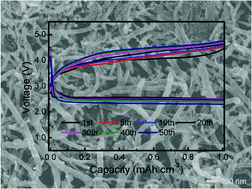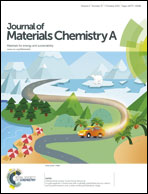A RuO2 nanoparticle-decorated buckypaper cathode for non-aqueous lithium–oxygen batteries†
Abstract
We report a non-aqueous lithium–oxygen battery with its cathode made of a RuO2 nanoparticle-decorated buckypaper (weaved with carbon nanotubes). Compared with conventional slurry-formed cathodes, the present cathode has two striking features: (i) no binder is required, avoiding the problems of surface-loss and instability due to the introduction of a polymeric binder, and (ii) no additional current collector is needed, increasing the practical specific capacity. The present battery demonstrates a discharge plateau of 2.56 V and a charge plateau of 4.10 V at a current density of 0.4 mA cm−2, with a discharge capacity of 4.72 mA h cm−2 (1150 mA h gcathode−1). It is also shown that at a fixed capacity of 2.0 mA h cm−2, the energy efficiency of the battery reaches 71.2%, 65.4%, and 58.0% at a current density of 0.2, 0.4, and 0.8 mA cm−2, respectively. Furthermore, the battery is able to operate for 50 cycles at a fixed capacity of 1.0 mA h cm−2, showing its good cycling stability. The results suggest that the RuO2 nanoparticle-decorated buckypaper cathode offers promise for a high-practical specific capacity, high-energy efficiency, and stable electrode for non-aqueous lithium–oxygen batteries.


 Please wait while we load your content...
Please wait while we load your content...